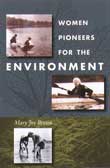
Women Pioneers for the
Environment
by Mary Joy Breton
Northeastern University Press,
1998, 336 pages
Want to buy it?
In 1993, Emma Must, irate over the British Department of Transport’s plans to plow through yet another grassy hillside for yet another highway extension, chained herself by the neck to the axle of a bulldozer for five hours. Her bold antics and those of a band of like-minded peaceful protestors stalled construction of the highway for six months, but ultimately their campaign failed. Out of the ashes of Must’s effort, however, rose a tide of public anger that swelled Britain’s anti-road movement and forced the DOT to dramatically scale back its building plans and reassess transportation policy throughout the country. For Must’s leadership in the anti-road movement, she earned a Goldman Environmental Prize in 1995, the environmental community’s equivalent of the Nobel.
Must is one of 42 activists and leaders profiled in Mary Joy Breton’s Women Pioneers for the Environment. Breton sketches the lives and achievements of an impressive cohort of 19th and 20th century women, as many unknown faces as famous figures.
Among the well-known women highlighted in the book are Gro Harlem Brundtland, former Norwegian prime minister and head of the U.N. commission that helped define sustainable development; Rachel Carson, author of Silent Spring and in many ways the mother of the modern environmental movement in the U.S.; and Wangari Maathai, leader of the highly successful Green Belt Movement, whose members have planted more than 17 million trees in Kenya. Lesser known environmentalists include Michiko Ishimuri, who organized victims of methyl mercury poisoning in a Japanese fishing village; Tatyana Artyomkina, who defied KGB threats to speak out against environmental degradation in the U.S.S.R.; and Katharine Ordway, a quiet American philanthropist who channeled at least $64 million toward land conservation.
Breton, as well as some of her subjects, seems to lean toward a vision of women sharing a common environmental consciousness, perhaps more finely tuned than that of men. In many ways, though, the similarities between the women profiled in her book are far less striking than the remarkable differences in their experiences, approaches, and accomplishments. Their collected stories showcase the broad diversity of the environmental movement and of human responses to the natural world.
Breton draws the majority of biographical information on her subjects from secondary rather than primary sources, and her profiles are brief, but she has pulled together an inspiring book, both a good reference volume and an enjoyable sit-down read.


